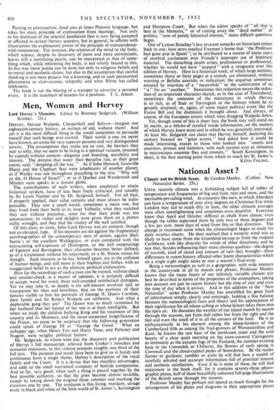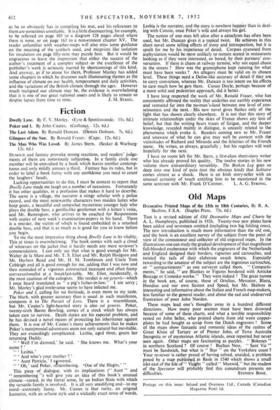National Asset.?
Climate and the British Scene. By Gordon Manley. (Collins. New Naturalist Series. 25s.) UNTIL recently climate was a forbidding subject full of tables of temperature and frequencies of fog and frost, rain and snow, and the inevitable prevailing wind. In a country like ours, in which Aberdeen can have a temperature of over sixty degrees on Christmas Eve while London may fail to reach fifty in June, the older climatic averages were often unenlightening and sometimes even deceitful. Everyone knew that April and October differed as chalk from cheese, even though the tables separated them by only two or three degrees and a few per cent. more days of wind from this or that direction. The change in treatment came when the climatologist began to study his daily weather charts. He then realised that a westerly wind was as likely to have come from the Greenland ice-cap as from the tropical Caribbean, with like diversity for winds of other directions; and he saw that, besides influencing their more obvious qualities—the degfee of warmth, kind of cloud and amount of rain they brought—these differences in recent history affected other latent characteristics which on a single night might make or mar a season's fruit-crop.
Being a meteorologist as well as a geographer, with wide interests in the countryside in all its moods and phases, Professor Manley knows that the many facets of our infinitely variable climate can best be described in terms of the properties of the atmosphere, taking into account not just its recent history but the time of year and even the -time of day when it arrives. And in this addition to the "New Naturalist" series Professor Manley has assembled his great fund of information simply, clearly and enticingly, holding a fine balance between the meteorological facts and theory and his appreciation of their significance for all whose calling or whose leisure takes them into the open air. He discuises the weather of our island month by month through the seasons, not from dull tables but from the sight and the feel and even the smell of it in all the corners of the land. He is as enthusiastically in his element among the sheep-farmers of the Cumberland fells as among the fruit-growers of Worcestershire and Kent: he knows the raw haar of the north-east coast and the cold beauty of a clear quiet morning on the snow-covered Cairngorms as intimately as the autumn fogs of the Fenland, the summer-evening haze in the Cotswolds or Chilterns, the flowers of early spring in Cornwall and the cloud-capped peaks of Snowdonia. Be the reader farmer or gardener, rambler or artist he will find here a wealth of carefully selected and accurate information full of practical interest and aesthetic satisfaction. Even if he is none of these, he will find enjoyment in the book itself, for it contains seventy-three photo- graphic plates, half of them beautifully coloured full-page illustrations of the British scene through the seasons. Professor Manley has perhaps not spared as much thought for the arrangement of his plates and diagrams in their appropriate places as he so obviously has in compiling his text, and his references to them are sometimes unreliable. It is a little disconcerting, for example, to be referred on page 103 to a diagram 128 pages ahead where there is none, or on page 163 to a non-existent chapter XV. The reader unfamiliar with weather-maps will also miss some guidance on the meaning of the symbols used, and misprints like isolation for insulation on page fifty-nine may puzzle him. But it would be ungracious to leave the impression that either the success of the author's treatment of a complex subject or the excellence of the publisher's work is seriously marred by shortcomings of this kind. And anyway, as if to atone for them, Professor Manley has added some chapters in which he discusses such illuminating themes as the influence of climate on our health, temperament and daily activities, and the variations of the British climate through the ages. However much maligned our climate may be, the evidence is overwhelming that it is one of our great national assets and is likely to remain so despite lapses from time to time. J. M. STAGG.



































 Previous page
Previous page